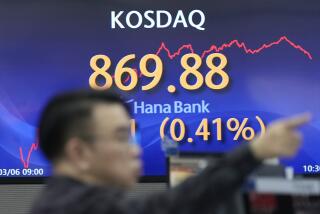Wall St. humbled by hedge funds
new york -- Hedge funds became the investment vehicle of choice for many pension plans and wealthy individuals in recent years, developing a cachet as can’t-miss outfits run by the investment world’s smartest minds.
But in the last few weeks, several prominent funds have been clobbered by turmoil in financial markets, denting the hedge-fund industry’s carefully honed image.
The latest casualty was revealed Monday as Goldman Sachs Group Inc., which has produced three U.S. Treasury secretaries and is considered Wall Street’s most elite firm, said it arranged to pump $3 billion into one of its funds that lost about one-third of its value last week alone. Some of the cash is coming from Los Angeles billionaire Eli Broad.
In part, the hedge fund industry may have grown too fast for its own good, with too many funds pursuing some of the same strategies, making it harder for any of them to earn the spectacular returns the industry first became known for.
And when one large fund runs into trouble, entire markets can be roiled, creating problems for everyday investors.
“There is an impeachment of credibility” of the hedge fund industry, says Charles Gradante, a principal at Hennessee Group, which advises fund investors.
The number of hedge funds worldwide has rocketed to nearly 10,000 from 5,400 five years ago. Their assets have surged to $1.7 trillion from $625 billion in the same period.
AQR Capital Management, one of the industry’s largest players, told clients in a letter Friday that returns on its funds that used a particular computer-driven strategy to trade stocks had been “shockingly bad” recently.
Why? “The very success of the strategy over time has drawn in too many investors,” AQR said.
Another problem hammering some hedge funds: their heavy use of borrowed money to magnify profits.
The use of debt helped trigger the demise last month of two multibillion-dollar hedge funds run by Bear Stearns Cos., another premier investment bank. The funds collapsed as their huge holdings of high-risk mortgage bonds crumbled.
Hedge funds -- largely unregulated private investment pools for the well-heeled -- are the ultimate opportunists, able to pursue virtually any investing or trading strategy in search of hefty returns for their clients.
But that same opportunism has led some of the portfolios to devastating losses this year.
In Goldman’s case, the $3.6-billion fund getting the capital infusion invested in stocks worldwide. The fund, called Global Equity Opportunities, didn’t simply buy and hold shares, however. Using sophisticated computer programs, it bought some stocks while “shorting” others, a bet that they would drop in price.
Last week, many of the fund’s bets went terribly awry and its value sank at least 30%, David Viniar, the brokerage’s chief financial officer, said during a conference call with investors.
Goldman blamed, in part, a surge in the stock market’s volatility.
But another problem was the fund’s use of borrowed money -- one of the main drawing cards of hedge funds. Goldman said the fund had borrowed six times the amount it had raised from its investors.
When securities prices are moving the way a hedge fund manager expects, the use of borrowed money can produce spectacular returns. But when markets go into a tailspin, investors who have loaded up with debt see their losses multiply and can be forced to quickly liquidate assets to pay down their loans.
Goldman said the Global Equity fund was in the process of paring its debts.
To be sure, in an industry with nearly 10,000 separate portfolios worldwide, not every hedge fund has been slammed. Many still are quite profitable year to date, depending on which of the myriad strategies they have followed with stocks, bonds or other securities. In part that’s because many of the funds actually do “hedge” -- meaning, they try to reduce the odds of incurring serious loss.
The average hedge fund was up 0.5% in July, according to Hedge Fund Research Inc. By contrast, the Standard & Poor’s 500 index of major U.S. stocks slumped 3.2% for the month.
The Goldman fund’s woes point up a challenge faced specifically by hedge managers known as “quants,” shorthand for quantitative, an increasingly popular investing style.
Hedge funds that follow quantitative strategies use computers to take the emotion out of investing. One popular strategy is called long/short: Basically, the computer is programmed to buy stocks of companies with strong business outlooks and sell those with weak outlooks.
But last week, stock markets worldwide hit a pocket of extraordinary volatility. Some investors were dumping shares of otherwise healthy companies, while other investors were buying beaten-down shares of weak companies.
That was the opposite of what Goldman’s computer programs had expected -- catching its fund flat-footed.
Wall Street’s trading programs “use a lot of tools of the math world that can’t deal with an unusual situation,” said Christopher Whalen, an analyst at research firm Institutional Risk Analytics, which analyzes the risks taken by financial firms.
That also was the case during the stock market crash of October 1987, and with the selling wave that hit stock and bond markets in late summer 1998, after the Russian government defaulted on its debt. The latter episode caused the failure of Long-Term Capital Management, one of the biggest hedge funds of its time.
Many computer-run hedge fund strategies have generated strong returns in recent years. But that success also may be their downfall.
In its letter to clients Friday, AQR Capital, a quantitative manager, said that “this isn’t about [computer] models, this is about a strategy getting too crowded.”
Goldman sought to put the best face on the capital infusion for its troubled fund. Goldman is providing $2 billion of the cash, with the other $1 billion coming from Eli Broad and Maurice Greenberg, the former chairman of insurance giant American International Group.
“This is not a rescue,” Viniar, the chief financial officer, said. Prices of the shares the fund owned were at irrationally low levels, he said. “Given the dislocation in the markets, we believe that this is a good investment opportunity for us and the other investors that we have brought in.”
By bringing two well-known billionaires into the fund, Goldman is hoping to keep existing investors aboard, analysts said.
A spokeswoman for Broad said he declined to comment on his investment. Greenberg couldn’t be reached for comment.
Keeping existing investors from pulling out their money could be crucial to the fund’s survival. Indeed, across the hedge fund industry, one major risk now is that a growing number of the funds’ investors will seek to pull out some or all of their money, rather than take the chance that markets will plunge further in coming months.
Many hedge funds allow investors to redeem at the end of each quarter, but require 45 days notice. That means letters of redemption would be due to those funds this week.
“We have to watch redemptions -- that could be another shoe” to drop on financial markets, said Gradante.
Heavy withdrawals could mean another round of selling of stocks and bonds by hedge funds, dragging markets lower, analysts warn.
tom.petruno@latimes.com






